In cadrul unei cooperari intre firma BITNET s.r.l.,Observatorul Astronomic din Cluj al Academiei Romane si Universitatea Tehnica din Cluj, in urma cu un an am demarat proiectul LEOSCOPE (Experimental Low Earth Orbit Surveillance Stereoscope) prin care testam posibilitatile de detectare optica si determinarea traiectoriei obiectelor ca se deplaseaza in apropierea Pamantului ( 200km-1000km). Principiul de baza este asemanator vederii stereoscopice, adica vom amplasa doi senzori optici identici, in doua locatii diferite aflate la aproximativ 37 km departare unul de celalalt. in acvest mod, vom avea un camp destul de larg de vedere stereoscopica. In mod simultan, folosind acelas standard de timp, se capteaza imagini ale zonei de interes. Printr-o prelucrare soft adecvata, se pot pune in evidenta diverse obiecte cu lumina proprie sau iluminate de Soare si se poate determina cu o oarecare precizie, pozitia lor si traiectoria.
Proiectul a fost prezentat in "abstract" la a X-a conferinta internationala AMOS ( Advanced Maui Optical and Space Surveillance Techologies Conference) desfasurata in septembrie 2009 la Maui, Hawaii. Aceasta Conferinta este considerata, de multi ani, un loc unde cei mai buni specialisti din lume se intalnesc sau isi comunica cercetarile referitoare la supravegherea optica a spatiului cosmic. In Hawaii , langa Maui, este amplasata una din cele mai performante facilitati al U.S. Air Force dedicate supravegherii optice. De altfel, multe lucrari prezentate sau publicate au ca autori cercetatori cunoscuti ai universitatilor americane sau ale fortelor armate ale S.U.A.
Puteti citi mai jos in original abstractul publicat:
Ultra-Wide Field of View Stereoscope for Low Earth Orbits Surveillance
Octavian Cristea, Paul Dolea
BITNET CCSS (The 10th Advanced Maui Optical and Space Surveillance Techologies Conference Maui, Hawaii, September 1-4 2009)
Optical detection of LEO objects with unknown orbital parameters is problematic. In a wide area search mission, an optical sensor collects frames of data on consecutive directions in order to find objects in its range of detection. Taking into account that a LEO object is fast moving on the sky and the visibility window is very small (the sky is clear, the sensor is in the Earth’s shadow and the object is above the horizon and illuminated), and taking into account a typical surveillance sensor FOV of less than one degree, the probability to detect unknown objects is very small. Another limitation is that accurate determination of the target’s position requires correlation of data from more than one passive sensor (a single passive sensor suffers from an inability to get unambiguous range data, even against fairly deterministic tracks such as satellites).
This paper examines the setup of a ground-based stereoscopic imager which can detect LEO objects and provide data regarding their orbits. In its minimal configuration, the stereoscope consists of a pair of (COTS) large aperture ultra-wide FOV lenses, backed with a high-quality CCD. While an ultra-wide FOV camera raises problems related to the detection magnitude and orbit estimation accuracy, such a camera significantly increases the probability of unknown objects detection.
The stereoscopes base-line is of the order of tens of Km, a compromise between simultaneous detection of low altitude objects from two locations and triangulation accuracy. Each camera continuously images the night sky and sends captured images to a local computer for off-line data processing. Each computer has a GPS card for pair cameras synchronization and it is connected to internet through a Ku band VSAT.
Geometric calibration of the image is made automatically, by matching captured stars in the image with an astronomical catalogue of stars. Making interpolation between these reference points, the computer attaches astronomical coordinates to each pixel of the sky image. This way, many errors due to light propagation through the atmosphere or f-Theta distortion can be corrected. The recovery of orbital depth is made by correlating matching feature points from pairs of simultaneous images. Since any pair of captured images practically contains the same star field, another application of the stereoscope is to produce 3D images of the night sky with LEO objects floating in front of the star field.
This project is in the concept development phase and it is based on a research cooperation agreement between BITNET CCSS, the Technical University of Cluj and the Astronomical
Observatory of Cluj.
Blogul Spacesignals prezinta o parte din preocuparile mele din urmatoarele domenii: Invatamant: ca initiator si fondator al Scolii de vara "Generatia Urmatoare" ce se desfasoara, anual, la Marisel; ca student, la Scoala Doctorala a Universitatii Tehnice din Cluj-Napoca. Cercetare: Obiecte spatiale din apropierea Pamantului (NEO); telecomunicatii asigurate de sateliti artificiali; activitatea solara si vremea spatiala; Unde electromagnetice de foarte joasa frecventa. Productie: Proiectare si executie de aparate si echipamente cu scop didactic sau pentru cercetare stiintifica; consultanta si prestari de servicii in telecomunicatii terestre sau satelitare. TOATE ARTICOLELE DE PE ACEST BLOG AU FOST SCRISE DE MINE. Aproape toate fotografiile de pe blog au fost facute de mine sau cu aparatul meu foto, acolo unde apar si eu in cadru. Am participat activ la proiectarea, instalarea echipamentelor si realizarea constructiilor aferente prezentate pe acest blog. Daca aveti sugestii sau alte idei pe care doriti sa mi le comunicati, nu ezitati sa-mi scrieti la adresa de mai jos:

Translate

Physical law should have mathematical beauty
P.A.M.DIRAC
P.A.M.DIRAC
Despre mine
- Paul Dolea
- Cluj-Napoca, Romania
- Am absolvit un liceu renumit din Cluj,cu specializare in electronica aplicata si tehnologii nucleare.Am urmat Facultatea de Fizica cu specializare in electronica si radiofizica.Dupa absolvire am fost profesor.In 1984 am obtinut acreditare de metrolog in domeniul Timp-frecvente si Coordonator al activitatii de metrologie la Directia de Radio si Televiziune Cuj. Din 2002 fac parte dintr-un colectiv de cercetare si dezvoltare in domeniul comunicatiilor prin satelit si supraveghere spatiala adanca.Am participat la proiectele TELSAT,HOTSAT,PORTASAT,SCANSAT,GOLIAT,DOG,LEOSCOPE,GENSO. Am participat la conferinte nationale si internationale in domeniu, am publicat zeci de articole stiintifice sau de popularizare a stiintei.Am initiat construirea Observatorului Astronomic Marisel si am lucrat direct la constructia lui precum si la realizarea Statiei de comunicatii in banda S cu sateliti artificiali ai Pamantului.Am initiat si am pus bazele Scolii de Vara "GENERATIA URMATOARE"-MARISEL. Din anul 2012 sunt cadru didactic asociat la Universitatea Tehnica din Cluj-Napoca, facultatea de Electronica Telecomunicatii si Tehnologia Informatiei.
CALIFICATIV: SUMMA CUM LAUDE
In 16 septembrie 2016 mi-am sustinut teza de doctorat in domeniul inginerie electronica si telecomunicatii la Universitatea Tehnica din Cluj-Napoca, obtinand calificativul maxim: „excelent”, adica „SUMMA CUM LAUDE”. Titlul tezei de doctorat: „Contributii la studiul undelor electromagnetice de joasa frecventa. Posibilitatati de receptie si aplicatii”
Comunicari stiintifice si articole publicate (autor sau coautor)
- Aspects regarding the use of the INFREP network for identifying possible seismic precursors
- Summer school in the field of Space Technologies: A novel approach for teenage education
- Aspects regarding the use of LF radio transmitters for time dissemination.
- Influence of sun elevation, azimuth and X-ray bursts on long distance VLF radio propagation
- Aspects regarding the characterization of in-orbit satellites using radio observations
- Low-cost SDR-based ground receiving station for LEO satellite operations
- In-situ measurements regarding LF radio wave propagation using DCF77 time signal transmitter
- Long baseline stereoscopic imager for close to Earth objects range measurements
- Improved VHF Ground Station For NOAA Weather Satellite APT Image Reception
- “LOW-Cost Prototype Equipment For VLF Radio Wave Monitoring”
- Aspects of a Low-Cost Ground Station Development for GENSO Network
- 4th of January 2011 Solar Eclipse Induced Disturbances in VLF Radio Waves Propagation
- Ultra-Wide Field of View Stereoscope for Low Earth Orbits Surveillance (abstract)
- Long base-line stereoscopic imager for close to Earth objects range measurement
- Developing an Experimental Multi-Band Orbital Activity Surveillance Sensor System in Romania
- S-band ground station prototype for low-earth orbit nanosatellite missions
Articole publicate pe blog in 2011
Articole publicate pe blog in 2010
- Universul a existat si inainte de Big Bang?
- Din nou despre extraterestri
- NASA a anuntat ca asistam la nasterea unei stele...
- Masurarea timpului
- Au fost mai aproape de stele...
- Generatia urmatoare. Ziua intai, ziua solstitiului
- Tabara tematica pilot "Generatia urmatoare"
- Singura solutie: o alta educatie!
- Internet prin satelit prin terminal VSAT
- Vremea spatiala
- Internet oriunde si oricand
- Romania se pregateste sa adere la CERN
- Din nou,proiectul Marisel
- Romania de azi si misterul flacarii violete
- Cerul noptii la inceput de saptamana
- Asteroidul 2010 AL30
- Asteroidul Apophis
Articole publicate pe blog (2007-2009)
- Proiectul HAARP si pericolul declansarii unui razboi geofizic
- Nanosatelitii si importanta lor
- Prognoza seismica este o himera?
- Parcul eolian Fantanele-Cogealac
- Rezonanta Schumann. Fabulatie si adevar.
- Proiectul LEOSCOP
- O intoarcere in timp...
- Sateliti artificiali ai Pamantului partea a II-a
- Diagrama de radiatie a antenei mesh de 3m
- Undele electromagnetice de joasa frecventa
- Mai bine mai tarziu decat niciodata...
- Au trecut 400 de ani...
- Am instalat o noua antena
- Am ridicat cupola pe observator
- S-au blocat retelele de telefonie
- Proiectul Marisel
- Azi aniversam internetul
- Despre extraterestri...
- Accident in spatiu
- GeoEye1-inca un ochi ne priveste din cer...
- Apendice matematic
- Timp si spatiu.Limitele Universului observabil
- Subspatiu,spatiu,hiperspatiu
- Sateliti artificiali ai Pamantului (1)
- A trecut o jumatate de secol
- Radiotelescopul de la Marisel
La Observatorul astronomic al Academiei Romane

Am fost la Global VSAT Forum

ABOUT ME
Paul Dolea
Cluj/ Romania/
If you are going to visit my site and read about my work and my theories, I think it would be a good idea to introduce myself to you, so that you could have a glimpse at the man behind these words.
I graduated from a renowned high school in Cluj-Napoca with a specialization in applied electronics and nuclear technologies. After high school, I attended the courses of The Faculty of Physics. When I graduated the faculty, I was specialized in electronics and radio-physics. One year after my graduation (meanwhile I was a teacher) I was accredited as Metrologist in the field of Time-frequencies and Coordinator of the metrological activity at the Radio and TV Institution Cluj.
For the moment, I am part of a group that is engaged in the research and development of satellite communication and deep spatial surveillance. I took part in projects like TELSAT, HOTSAT, PORTASAT, SCANSAT, GOLIAT, DOG. I also joined the team that in 2011 will launch the first Romanian micro satellite, under the coordination of the Romanian Space Agency. I was invited to national and international conferences, including conferences organized by NATO or NASA.
I am married and I have a very pretty girl. I speak Romanian, Hungarian, French and English. I am fascinated by everything that is connected to time and space, at the scale of the more or less observable Universe.
Cluj/ Romania/
If you are going to visit my site and read about my work and my theories, I think it would be a good idea to introduce myself to you, so that you could have a glimpse at the man behind these words.
I graduated from a renowned high school in Cluj-Napoca with a specialization in applied electronics and nuclear technologies. After high school, I attended the courses of The Faculty of Physics. When I graduated the faculty, I was specialized in electronics and radio-physics. One year after my graduation (meanwhile I was a teacher) I was accredited as Metrologist in the field of Time-frequencies and Coordinator of the metrological activity at the Radio and TV Institution Cluj.
For the moment, I am part of a group that is engaged in the research and development of satellite communication and deep spatial surveillance. I took part in projects like TELSAT, HOTSAT, PORTASAT, SCANSAT, GOLIAT, DOG. I also joined the team that in 2011 will launch the first Romanian micro satellite, under the coordination of the Romanian Space Agency. I was invited to national and international conferences, including conferences organized by NATO or NASA.
I am married and I have a very pretty girl. I speak Romanian, Hungarian, French and English. I am fascinated by everything that is connected to time and space, at the scale of the more or less observable Universe.
Popular Posts
-
1. INTRODUCERE Nu demult, un zvon cutremurător dar absolut neştiintific s-a răspândit prin intermediul mass-media pe întreg globul pământesc...
-
Echipamentele, aparatura de masura si elementele circuitelor de foarte inalta frecventa sunt destul de diferite de cele utilizate in domeniu...
-
Pe scurt : Actualele dezvoltari stiintifice si tehnologice necesita o masurare a timpului cat mai precisa. Pentru a permite atingerea unor ...
-
Una din cele mai mari investitii actuale din Romania se face in domeniul energetic. Iar faptul ca se realizeaza un parc eolian de mari d ime...
-
Pe scurt: Soarele este o stea variabilă. Această variabilitate se manifestă printr-o intensificare a activităţii solare urmată de o perioadă...
-
In editia electronica a postului Realitatea a fost publicat, intr-una din zilele trecute, un articol cu titlul : Altă APOCALIPSĂ? Planet...
-
INTRODUCERE http://paul-dolea.blogspot.com / ( english) In cele ce urmeaza voi incerca sa sintetizez o idee ce ma preocupa de mai bine de ...
-
TRANSMITEREA INFORMATIEI PRIN UNDE ELECTROMAGNETICE DE ULTRA JOASA FRECVENTA Eseu pregatit pentru colocviul de admitere la doctorat, septemb...
-
Senzorul de camp electromagnetic de joasa frecventa (VLF,ULF,SLF si ELF) bazat pe fenomenul de inductie a fost realizat cu sprijinul direct ...
-
ACTUALIZARE (06 iunie 2012 ora 11:00 UTC) Aseara am fixat desteptatorul pentru ora 04:30 (ora Romaniei) asa ca pentru mine ziua de lucru ...
Articole pe care le-am publicat recent in reviste
In ultima vreme am incercat sa transmit si altora, prin presa electronica, o parte din opiniile mele si cunostintele pe care le-am acumulat in decursul anilor. Astfel, o mare parte din materialele prezentate pe aceasta pagina de internet le gasiti publicate in mai multe reviste unde au acumulat zeci de mii de afisari.
Despre extraterestri...
Parerea mea despre "extraterestri"...
(...) A crede ca in intreg Universul, doar Pamantul este capabil sa intretina viata, este la fel de absurd ca si conceptia geocentrista, care postula ca Pamantul este centrul sistemului solar si chiar a intregului Univers... Problema devine mai interesanta daca punem conditia ca pe un alt corp ceresc sa se dezvolte viata inteligenta asemenea cu a oamenilor de pe Pamant. Daca ne gandim la diversitatea fiintelor vii de pe Pamant si la faptul ca noi, oamenii, inca nu am reusit sa facem un schimb de informatii cu ele, ce sanse avem sa "detectam" inteligenta extraterestra? Asta nu inseamna ca trebuie sa ne resemnam, dar trebuie sa gasim metode ce se bazeaza pe principii fizice universal valabile si nu doar pe modul nostru de gandire. Pe Pamant exista foarte multe forme de viata, conditiile de mediu sunt aceleasi pentru ele ca si pentru oameni dar cu toate acestea nu am auzit vreuna sa "gandeasca" asemenea rasei umane. Eu cred ca inteligenta umana este mai veche decat viata de pe Pamant, eu cred ca vom gasi "rude" in alte sisteme stelare si cred ca aceasta continua sete de cunoastere ne va deschide drumuri noi, spre alte stele asemanatoare Soarelui nostru, iar atunci cand viata pe Pamant va deveni imposibila,vom duce cu noi mostenirea genetica a unor stramosi veniti din alte parti ale Universului.
(...) A crede ca in intreg Universul, doar Pamantul este capabil sa intretina viata, este la fel de absurd ca si conceptia geocentrista, care postula ca Pamantul este centrul sistemului solar si chiar a intregului Univers... Problema devine mai interesanta daca punem conditia ca pe un alt corp ceresc sa se dezvolte viata inteligenta asemenea cu a oamenilor de pe Pamant. Daca ne gandim la diversitatea fiintelor vii de pe Pamant si la faptul ca noi, oamenii, inca nu am reusit sa facem un schimb de informatii cu ele, ce sanse avem sa "detectam" inteligenta extraterestra? Asta nu inseamna ca trebuie sa ne resemnam, dar trebuie sa gasim metode ce se bazeaza pe principii fizice universal valabile si nu doar pe modul nostru de gandire. Pe Pamant exista foarte multe forme de viata, conditiile de mediu sunt aceleasi pentru ele ca si pentru oameni dar cu toate acestea nu am auzit vreuna sa "gandeasca" asemenea rasei umane. Eu cred ca inteligenta umana este mai veche decat viata de pe Pamant, eu cred ca vom gasi "rude" in alte sisteme stelare si cred ca aceasta continua sete de cunoastere ne va deschide drumuri noi, spre alte stele asemanatoare Soarelui nostru, iar atunci cand viata pe Pamant va deveni imposibila,vom duce cu noi mostenirea genetica a unor stramosi veniti din alte parti ale Universului.

PREVIZIUNI METEO ON-LINE
Daca accesati linkurile de mai jos, veti putea vedea miscarea cea mai probabila a formatiunilor noroase din aceasta zona a Europei in urmatoarele 5 zile, deasemenea, prognoze referitoare la tempertatura aerului si precipitatii. Pentru a accesa fiecare aplicatie va trebui sa apasati butonul PLAY ce se va gasi in partea de sus dreapta a paginii afisate. Va aparea o grafica animata cu previziunile meteo din 6 in 6 ore. Veti putea accelera animatia , o veti putea opri la data si ora ce va intereseaza sau o veti putea actiona manual. Datele sunt oferite de Universitatea din Atena, departamentul pentru fizica mediului.
Cutremurele de Pamant
Cutremurul de pamant poate fi considerat cel mai imprevizibil si cel mai catasrofal fenomen al naturii. Se cunosc de zeci de ani importantele placi tectonice ale Terrei si zonele cu risc seismic ridicat. Ceea ce nu se cunoaste este metoda prin care sa se faca, in acest domeniu, prognoze cu un grad ridicat de credibilitate stiintifica. Incercari s-au facut si se fac in continuare, tari dezvoltate alocand fonduri substantiale in aceasta directie. Iar pana atunci nu ne ramane decat sa urmarim cu oarecare teama, penitele seismografelor.
In urma cu cativa ani am instalat, la cateva statii seismologice ale Institutului National pentru Fizica Pamantului (INFP), echipamentele de telecomunicatii prin satelit destinate monitorizarii activitatilor nucleare subterane, de catre International Atomic Energy Agency. Am ramas impresionat de echipamentele ultrasensibile dedicate punerii in evidenta a celor mai slabe miscari telurice si de profesionalismul celor care le intretin si interpreteaza datele culese.
In urma cu cativa ani am instalat, la cateva statii seismologice ale Institutului National pentru Fizica Pamantului (INFP), echipamentele de telecomunicatii prin satelit destinate monitorizarii activitatilor nucleare subterane, de catre International Atomic Energy Agency. Am ramas impresionat de echipamentele ultrasensibile dedicate punerii in evidenta a celor mai slabe miscari telurice si de profesionalismul celor care le intretin si interpreteaza datele culese.
Pamantul poate fi lovit de un asteroid sau o cometa?
Din cele mai vechi timpuri, oamenii au privit cu oarecare teama spre cer. Un spatiu imens, necunoscut si plin de surprize. De multe ori fenomene meteorologice violente sau evenimente astronomice remarcabile au accentuat sentimentul de nesiguranta sau chiar au produs panica in randul populatiei.
In ultimul timp, de cand observatiile astronomice se fac cu echipamente foarte performante si datele sunt prelucrate si analizate cu sisteme de calcul extrem de puternice, se fac prognoze destul de credibile privind posibilitatea ca planeta noastra sa fie lovita in mod catastrofal de un corp ceresc. In revista StiintaAzi.ro veti gasi articolul ce l-am scris mai demult, pe aceasta tema.
http://www.stiintaazi.ro/index.php?view=article&id=2605%3Apamantul-in-pericol&option=com_content&Itemid=58
Daca urmati link-ul de mai jos, veti gasi un tabel al previziunilor NASA privind aceasta posibilitate.
In ultimul timp, de cand observatiile astronomice se fac cu echipamente foarte performante si datele sunt prelucrate si analizate cu sisteme de calcul extrem de puternice, se fac prognoze destul de credibile privind posibilitatea ca planeta noastra sa fie lovita in mod catastrofal de un corp ceresc. In revista StiintaAzi.ro veti gasi articolul ce l-am scris mai demult, pe aceasta tema.
http://www.stiintaazi.ro/index.php?view=article&id=2605%3Apamantul-in-pericol&option=com_content&Itemid=58
Daca urmati link-ul de mai jos, veti gasi un tabel al previziunilor NASA privind aceasta posibilitate.
Explorarea spatiului cosmic printr-un program european
Proiecte internationale de mare anvergura ce au ca obiectiv explorarea spatiului cosmic se desfasoara sub patronajul Agentiei Spatiale Europene (European Space Agency). Daca urmariti link-ul ce vi l-am indicat mai jos, puteti sa aflati ultimele noutati privind activitatea agentiei si tendintele europene privind explorarea spatiului extraatmosferic.
Pozitia in timp real a unor sateliti
Daca doriti sa aflati pozitia in timp real a unor sateliti cu orbita inclinata, accesati link-ul de mai jos. Avand ca fundal suprafata globului, simbolul aferent satelitul urmarit se deplaseaza, reprezentand intuitiv pozitia lui in raport cu continentele sau oceanele pe care le survoleaza. Puteti sa gasiti aici o multitudine de informatii privind destinatia si parametrii orbitali ai unor sateliti artificiali.
Nanosatelitii si rolul lor in cercetarea spatiului cosmic
In ultimii ani, un numar din ce in ce mai mare de sateliti de foarte mici dimensiuni au fost plasati pe orbite circumterestre. Majoritatea sunt construiti de unitati de invatamant renumite sau organisme de cercetare din domeniu. Dar care sunt avantajele oferite de utilizarea unor astfel de nanosateliti?De ce se aloca fonduri substantiale pentru perfectionarea si dezvoltarea acestei activitati?
Tendinta actuala (in aceasta zona de interes) este de a echipa si lansa nanosateliti construiti pe o structura cubica ce are latura de 10 cm. Daca acest volum este considerat prea mic, se utilizeaza doua sau mai multe cuburi, cuplate intre ele atat mecanic cat si electric. Se incearca in acest mod sa se ajunga la o oarecare standardizare, pastrandu-se totusi flexibilitatea alegerii echipamentelor aflate la bord.
Acest mod de proiectare reduce substantial pretul satelitului, devenind accesibil chiar si unor organizatii ce dispun de fonduri reduse.
Deasemenea, costurile aferente plasarii lor pe orbita sunt mult mai mici deoarece o racheta purtatoare poate transporta, pe langa unul sau mai multi sateliti de dimensiuni mari, zeci de astfel de nanosateliti.
Un alt avantaj consta in faptul ca, daca apar probleme la lansare sau in timpul exploatarii, pierderea unui astfel de satelit nu devine o catastrofa financiara.
Dar pe langa avantajele enumerate mai sus, exista inca unul ce nu este de loc neglijabil: Fiind atat de mici, sunt greu de detectat iar distrugerea lor este foarte dificila.
Pentru a compensa in parte posibilitatile limitate de echipare cu aparatura, tendinta actuala este de a crea microsateliti care sa zboare "in flotila" avand si multe functii redundante, astfel incat daca apar probleme functionale la unul din ei, functiile respective sunt preluate de satelitul din imediata sa apropiere.
Aceste avantaje justifica interesul marilor companii aeronautice pentru micii sateliti.
Tendinta actuala (in aceasta zona de interes) este de a echipa si lansa nanosateliti construiti pe o structura cubica ce are latura de 10 cm. Daca acest volum este considerat prea mic, se utilizeaza doua sau mai multe cuburi, cuplate intre ele atat mecanic cat si electric. Se incearca in acest mod sa se ajunga la o oarecare standardizare, pastrandu-se totusi flexibilitatea alegerii echipamentelor aflate la bord.
Acest mod de proiectare reduce substantial pretul satelitului, devenind accesibil chiar si unor organizatii ce dispun de fonduri reduse.
Deasemenea, costurile aferente plasarii lor pe orbita sunt mult mai mici deoarece o racheta purtatoare poate transporta, pe langa unul sau mai multi sateliti de dimensiuni mari, zeci de astfel de nanosateliti.
Un alt avantaj consta in faptul ca, daca apar probleme la lansare sau in timpul exploatarii, pierderea unui astfel de satelit nu devine o catastrofa financiara.
Dar pe langa avantajele enumerate mai sus, exista inca unul ce nu este de loc neglijabil: Fiind atat de mici, sunt greu de detectat iar distrugerea lor este foarte dificila.
Pentru a compensa in parte posibilitatile limitate de echipare cu aparatura, tendinta actuala este de a crea microsateliti care sa zboare "in flotila" avand si multe functii redundante, astfel incat daca apar probleme functionale la unul din ei, functiile respective sunt preluate de satelitul din imediata sa apropiere.
Aceste avantaje justifica interesul marilor companii aeronautice pentru micii sateliti.

Astronomia secolului XXI
In spatiul interstelar fenomenele de absorbtie si de imprastiere a luminii datorate atmosferei terestre dispar. Acest fapt a condus la ideea plasarii unui telescop de dimensiuni mari, pe o orbita circumterestra. Imaginile surprinse sunt dintr-o lume ireala. Daca urmati link-ul de mai jos, veti putea vedea imagini ale unor galaxii indepartate, inregistrate de telescopul HUBBLE.

Cercul de stele
Galerie foto: constructia antenei Patriot
Instantaneele de mai jos au fost facute in urma cu 3 ani, cand am inceput lucrarile la poligonul de radiocomunicatii din Marisel, prin instalarea primei antene de mari dimensiuni. Dupa cum se vede, am fost sprijiniti si de localnici carora, si pe aceasta cale, le multumesc. Deasemenea multumesc si firmei METAHAL srl din Cluj pentru sprijin.












Antena Patriot de 3.8m
In frumoasele zile ale lunii octombrie 2006, o echipa de (mai putin) tineri dar entuziasti, a "plantat" pe un platou montan, la altitudinea de 1250m, o parabola de 4m diametru cu o fundatie de 12 tone , echipata cu motoare pentru... controlul azimutului si al elevatiei, cu ghiduri de unda si LNB-uri pentru scanarea cerului in banda C si benzile Ku. S-a realizat in acest fel un mic radiotelescop. Controlul radiotelescopului se face cu microcontrolere. Echipa de entuziasti a fost formata din fiz.Octavian Cristea, fiz.Paul Dolea si ing.Gheorghe Stanciu.
Constructie observator (1)
Am inceput constructia cladirii care urmeaza sa adaposteasca laboratorul radio si telescopul in vara anului 2008. Cupola nu a fost livrata decat in ianuarie 2009, asa ca am acoperit complet cladirea pentru a o proteja de intemperii. Aveti mai jos o galerie foto sugestiva referitoare la principalele etape ale constructiei.










Constructie observator (2)
Dupa ce a sosit cupola din fibra de sticla fabricata in Maryland, am decopertat o parte din constructie, am executat o adaptare a a formei si a dimensiunilor constructiei de baza la forma si dimensiunile cupolei, am montat pilonul telescopului si am podit camera rece, ca sa o izolam termic si sa devina "calda". In galeria de mai jos, puteti vedea fazele acestei lucrari.











Construirea antenei mesh de 3m
Pentru a putea receptiona semnale in banda S de la satelitii LEO antenele directive trebuie sa urmareasca deplasarea acestor sateliti. Antena trebuie motorizata, comandata de computer si sa poata fi indreptata spre orice punct de pe bolta cerului. Gasiti mai jos o galerie foto cu etapele montajului.








Cateva din lucrarile pe care le-am proiectat si executat in ultimii 5 ani
In ultimii ani am executat Site Survey pentru sute de amplasamente de parabole de receptie DTH, zeci de VSAT-uri pentru comunicatii two-way prin satelit. Pentru toate acestea am conceput proiectele si am executat lucrarile de montaj si punere in functiune, de unul singur. Deasemenea, in 2006 am demarat Proiectul Marisel, prin instalarea antenei parabolice Patriot AZ-EL de 3.8m diametru. In 2008 am proiectat cladirea Observatorului Astronomic Marisel si am inceput constructia (aflata acum in stadiu de "rosu"). In 2009 am instalat antena "mesh" de 3m motorizata, cu sight of line horizon- to - horizon, destinata comunicatiilor cu sateliti de joasa altitudine (LEO)
Tranisu 2005
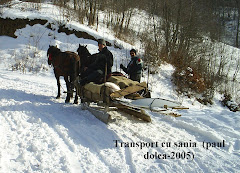
Direct-To-Home SAT-TV
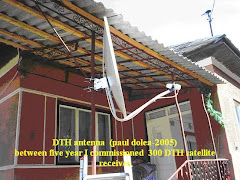
Dual Antenna System

Internet in residential area

Virtual Private Network by satellite

Broadband by satellite in rural area

Vatra Dornei-2005

My Workdesk-2006

NATO RTO meeting 2006
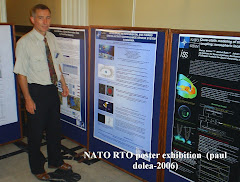
Romanian Academy Astronomical Observatory

OpenSky data receiver system
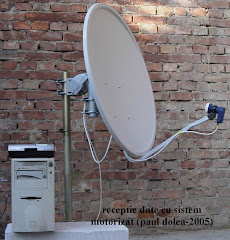
Antena Patriot de 3.8m in timpul constructiei

International Atomic Energy Agency (IAEA) Network
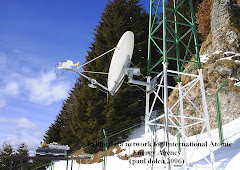
Prima TV for Cluj City

European Private Network
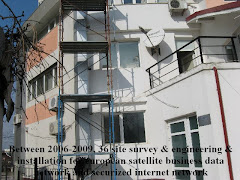
S-Band 3m Mesh Antenna















